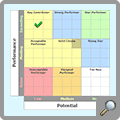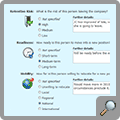The talent review for a person describes their key talent information.
In general people will only have one talent review but as they develop over time
you can take snapshots of their review to preserve historic data.
A talent review is split in to four main sections; each looking at a different aspect
of the talent for the person. You do not need to complete all of the sections if
you do not wish to.
Performance and Potential
The performance and potential of an individual is used to determine their overall
rating. Put simply: “How well are they performing now and how well could they contribute
in the future?”

The performance and potential is represented by a grid divided into 81 squares,
representing a combination of 9 levels of performance and 9 levels of potential.
Moving up and down the grid indicates how well the individual is performing, the
closer to the top the higher the performance and vice versa. Moving left and right
on the grid indicates the potential of the individual, the closer to the right the
higher the potential and vice versa.
Clicking on the appropriate box on the grid will set the performance and potential
scores for the individual and place them in one of the coloured boxes, which in
turn determines their overall rating (such as Star Performer or Key Contributor).
The names of the boxes on the grid can be customised by account administrators.
You can also enter a short paragraph that summarises the rating for the person.
Talent Dimensions
The talent dimensions for the person cover how they are viewed within the organisation
on a number of different points. They are some of the most important aspects of
the talent review and allow you to perform detailed analysis of your people later
on.

The four dimensions are:
- Retention Risk - Indicating the risk of the person leaving the company.
- Readiness - Indicating how read the person is to move into a new position.
- Mobility - Indicating how far the person is willing to relocate for a new
position.
- Career Trajectory - Indicating the direction in which the person's career
is heading.
You can also provide a short, supporting comment against each dimension.
Education and Experience
The education and experience section allows you to record any qualifications that
the person holds and the skills, knowledge and capability that they bring to your
organisation.
Comments
The comments section allows you to capture any additional information about the
person that is relevant and you were not able to record in any of the other sections.